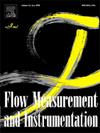利用浸入边界晶格玻尔兹曼方法探讨细丝在通道流动修正中的作用
IF 2.3
3区 工程技术
Q2 ENGINEERING, MECHANICAL
引用次数: 0
摘要
在微缩模型上操纵流是一项具有挑战性的任务。本研究利用浸入式边界晶格玻尔兹曼(IB-LBM)方法探讨了弹性细丝在控制通道内流场中的潜在应用。通道宽度为4 cm,初始弹性丝长为1.3 cm。细丝在通道中心和壁上的存在分别进行了研究。对于通道中间有两根倾斜弹性丝的情况,结果表明,弹性丝在流体动量的影响下偏离了其原始状态,并倾向于向流动方向移动。细丝拉伸并到达最终位置,然后在弹性和背后形成的漩涡的影响下开始振荡。当10根细丝分布在上下壁上并保持一定距离时,研究结果表明,最初在通道入口附近的细丝会对流动产生扰动,并在通道末端产生较大的涡。然而,随着时间的推移,当流动达到稳定状态时,细丝后面形成小漩涡,细丝开始振荡,通道内的主流保持相当均匀,没有明显的漩涡。本文章由计算机程序翻译,如有差异,请以英文原文为准。
Exploring the role of filaments in channel flow modification using the immersed boundary lattice Boltzmann method
Manipulating flow at the miniature is a challenging task. This study explores the potential application of elastic filaments to manipulate the flow field in a channel using the immersed boundary-lattice Boltzmann (IB-LBM) method. The channel width and the initial elastic filament length were 4 cm and 1.3 cm, respectively. The presence of the filaments on the channel's center and walls is investigated separately. For the case with two inclined elastic filaments in the middle of the channel, the results showed that the elastic filament deviates from its original state under the influence of the fluid momentum and tends to move in the direction of the flow. The filaments stretch and reach their final position, then start to oscillate under the influence of elasticity and vortexes formed behind them. For the case with 10 filaments distributed over the top and bottom walls with a constant distance between them, the results show that initially the filaments near the entrance cause a disturbance in the flow and induce large vortexes at the end of the channel. However, over time, as the flow reaches a steady state, small vortexes form behind the filaments and, the filaments start to oscillate and the main flow inside the channel remains pretty uniform without obvious vortexes.
求助全文
通过发布文献求助,成功后即可免费获取论文全文。
去求助
来源期刊

Flow Measurement and Instrumentation
工程技术-工程:机械
CiteScore
4.30
自引率
13.60%
发文量
123
审稿时长
6 months
期刊介绍:
Flow Measurement and Instrumentation is dedicated to disseminating the latest research results on all aspects of flow measurement, in both closed conduits and open channels. The design of flow measurement systems involves a wide variety of multidisciplinary activities including modelling the flow sensor, the fluid flow and the sensor/fluid interactions through the use of computation techniques; the development of advanced transducer systems and their associated signal processing and the laboratory and field assessment of the overall system under ideal and disturbed conditions.
FMI is the essential forum for critical information exchange, and contributions are particularly encouraged in the following areas of interest:
Modelling: the application of mathematical and computational modelling to the interaction of fluid dynamics with flowmeters, including flowmeter behaviour, improved flowmeter design and installation problems. Application of CAD/CAE techniques to flowmeter modelling are eligible.
Design and development: the detailed design of the flowmeter head and/or signal processing aspects of novel flowmeters. Emphasis is given to papers identifying new sensor configurations, multisensor flow measurement systems, non-intrusive flow metering techniques and the application of microelectronic techniques in smart or intelligent systems.
Calibration techniques: including descriptions of new or existing calibration facilities and techniques, calibration data from different flowmeter types, and calibration intercomparison data from different laboratories.
Installation effect data: dealing with the effects of non-ideal flow conditions on flowmeters. Papers combining a theoretical understanding of flowmeter behaviour with experimental work are particularly welcome.
 求助内容:
求助内容: 应助结果提醒方式:
应助结果提醒方式:


